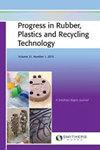Development of textile printing ink using expanded polystyrene waste as a binder
IF 1.6
4区 材料科学
Q4 MATERIALS SCIENCE, COMPOSITES
Progress in Rubber Plastics and Recycling Technology
Pub Date : 2023-06-30
DOI:10.1177/14777606231186635
引用次数: 0
Abstract
This research produced textile pigment printing paste using expanded polystyrene (EPS) as a binder, sodium alginate as a thickener, and ultramarine pigment. The printing paste production was optimized through response surface methodology, using central composite design (CCD). The dynamic viscosity of the produced printing paste samples ranges from 5200 to 5550.50 cP (Centi Poise). The Fourier infrared transform (FTIR) spectroscopy revealed the functional groups present in the printing paste. The result of the thermogravimetric analysis (TGA) conducted shows a first step decomposition of 94.14% that occurred at the range of 30.96°C–127.75°C. Differential scanning calorimetry (DSC) showed an endothermic transition at 119.44°C due to the absorption of energy during the breaking of printing paste bonds. Textile characterization such as wash fastness, croak fastness, and light fastness was carried out to determine the suitability of the print paste on cotton and polyester fabrics. The results of the fastness tests range from 4 to 5 for wash fastness, 3 to 4/5 for croak fastness, and 4 to 6 for light fastness. The optimum values of the model variables are thickener (50%), binder (40%), and pigment (5%). The performance of the printing paste as revealed from the results is moderate and comparable with textile printing paste suitable for commercial application.用膨胀聚苯乙烯废料作粘合剂的纺织油墨的研制
本研究以膨胀聚苯乙烯(EPS)为粘合剂,海藻酸钠为增稠剂,深蓝色颜料为原料,制备纺织颜料印花浆料。采用响应面法,采用中心复合设计(CCD)对印刷浆料的生产工艺进行优化。生产的印花浆料样品的动态粘度范围为5200至5550.50 cP (Centi Poise)。傅里叶红外变换(FTIR)光谱揭示了印刷浆料中存在的官能团。热重分析(TGA)结果表明,在30.96℃- 127.75℃范围内,第一步分解率为94.14%。差示扫描量热法(DSC)显示,在119.44℃时,由于印刷浆料键断裂时吸收了能量,发生了吸热转变。通过对织物的洗涤牢度、耐蚀牢度、耐光牢度等性能的测试,确定了印花浆料在棉、涤织物上的适用性。耐洗牢度测试结果为4 - 5分,耐蚀牢度为3 - 4/5分,耐光牢度为4 - 6分。模型变量的最佳值为增稠剂(50%)、粘结剂(40%)和颜料(5%)。结果表明,该印花浆料性能适中,可与适合商业应用的纺织印花浆料相媲美。
本文章由计算机程序翻译,如有差异,请以英文原文为准。
求助全文
约1分钟内获得全文
求助全文
来源期刊

Progress in Rubber Plastics and Recycling Technology
MATERIALS SCIENCE, COMPOSITES-POLYMER SCIENCE
CiteScore
4.40
自引率
7.70%
发文量
18
审稿时长
>12 weeks
期刊介绍:
The journal aims to bridge the gap between research and development and the practical and commercial applications of polymers in a wide range of uses. Current developments and likely future trends are reviewed across key areas of the polymer industry, together with existing and potential opportunities for the innovative use of plastic and rubber products.
 求助内容:
求助内容: 应助结果提醒方式:
应助结果提醒方式:


